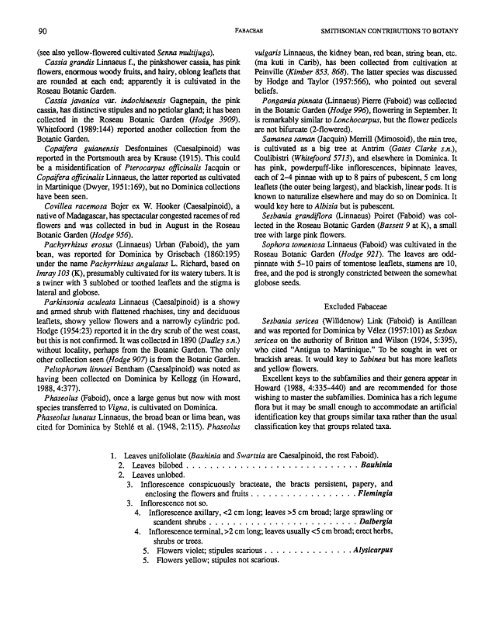Flora of Dominica, Part 2 - Smithsonian Institution Libraries
Flora of Dominica, Part 2 - Smithsonian Institution Libraries
Flora of Dominica, Part 2 - Smithsonian Institution Libraries
You also want an ePaper? Increase the reach of your titles
YUMPU automatically turns print PDFs into web optimized ePapers that Google loves.
90 FABACEAE SMITHSONUN CONTRIBUTIONS TO BOTANY<br />
(see also yellow-flowered cultivated Sennu multijuga).<br />
Cassia grandis Linnaeus f., the pinkshower cassia, has pink<br />
flowers, enormous woody hits, and hairy, oblong leaflets that<br />
are rounded at each end; apparently it is cultivated in the<br />
Roseau Botanic Garden.<br />
Cassia javanica var. indochinensis Gagnepain, the pink<br />
cassia, has distinctive stipules and no petiolar gland; it has been<br />
collected in the Roseau Botanic Garden (Hodge 3909).<br />
Whitefoord (1989:144) reported another collection from the<br />
Botanic Garden.<br />
Copuifera guiunensis Desfontaines (Caesalpinoid) was<br />
reported in the Portsmouth area by Krause (1915). This could<br />
be a misidentification <strong>of</strong> Pterocarpus <strong>of</strong>icinalis Jacquin or<br />
Copaifera <strong>of</strong>icinulis Linnaeus, the latter reported as cultivated<br />
in Martinique (Dwyer, 1951:169), but no <strong>Dominica</strong> collections<br />
have been seen.<br />
Covillea racemosa Bojer ex W. Hooker (Caesalpinoid), a<br />
native <strong>of</strong> Madagascar, has spectacular congested racemes <strong>of</strong> red<br />
flowers and was collected in bud in August in the Roseau<br />
Botanic Garden (Hodge 956).<br />
Pachyrrhizus erosu (Linnaeus) Urban (Faboid), the yam<br />
bean, was reported for <strong>Dominica</strong> by Grisebach (1860:195)<br />
under the name Pachyrrhizus angulatus L. Richard, based on<br />
Zmruy 103 (K), presumably cultivated for its watery tubers. It is<br />
a twiner with 3 sublobed or toothed leaflets and the stigma is<br />
lateral and globose.<br />
Parkinsonia aculeata Linnaeus (Caesalpinoid) is a showy<br />
and armed shrub with flattened rhachises, tiny and deciduous<br />
leaflets, showy yellow flowers and a narrowly cylindric pod.<br />
Hodge (1954:23) reported it in the dry scrub <strong>of</strong> the west coast,<br />
but this is not confirmed. It was collected in 1890 (Dudley s.n.)<br />
without locality, perhaps from the Botanic Garden. The only<br />
other collection seen (Hodge 907) is from the Botanic Garden.<br />
Peltophorum linnuei Bentham (Caesalpinoid) was noted as<br />
having been collected on <strong>Dominica</strong> by Kellogg (in Howard,<br />
1988,4:377).<br />
Phuseolus (Faboid), once a large genus but now with most<br />
species transferred to Vigna, is cultivated on <strong>Dominica</strong>.<br />
Phaseolus lunatus Linnaeus, the broad bean or lima bean, was<br />
cited for <strong>Dominica</strong> by Stehle et al. (1948, 2115). PhuseoIus<br />
vulgaris Linnaeus, the kidney bean, red bean, string bean, etc.<br />
(ma kuti in Carib), has been collected from cultivation at<br />
Peinville (Kimber 853,868). The latter species was discussed<br />
by Hodge and Taylor (1957:566), who pointed out several<br />
beliefs.<br />
Pongamia pinnata (Linnaeus) Pierre (Faboid) was collected<br />
in the Botanic Garden (Hodge 996), flowering in September. It<br />
is remarkably similar to Lonchocarpus, but the flower pedicels<br />
are not bifurcate (2-flowered).<br />
Samunea samun (Jacquin) Merrill (Mimosoid), the rain tree,<br />
is cultivated as a big tree at Antrim (Gates Clarke s.n.),<br />
Coulibistri (Whitefoord 5713), and elsewhere in <strong>Dominica</strong>. It<br />
has pink, powderpuff-like inflorescences, bipinnate leaves,<br />
each <strong>of</strong> 2-4 pinnae with up to 8 pairs <strong>of</strong> pubescent, 5 cm long<br />
leaflets (the outer being largest), and blackish, linear pods. It is<br />
known to naturalize elsewhere and may do so on <strong>Dominica</strong>. It<br />
would key here to Albizia but is pubescent.<br />
Sesbania grandiflora (Linnaeus) Poiret (Faboid) was collected<br />
in the Roseau Botanic Garden (Bassett 9 at K), a small<br />
tree with large pink flowers.<br />
Sophora tomentosa Linnaeus (Faboid) was cultivated in the<br />
Roseau Botanic Garden (Hodge 921). The leaves are oddpinnate<br />
with 5-10 pairs <strong>of</strong> tomentose leaflets, stamens are 10,<br />
free, and the pod is strongly constricted between the somewhat<br />
globose seeds.<br />
Excluded Fabaceae<br />
Sesbania sericea (Willdenow) Link (Faboid) is Antillean<br />
and was reported for <strong>Dominica</strong> by V6lez (1957: 101) as Sesban<br />
sericea on the authority <strong>of</strong> Britton and Wilson (1924, 5:395),<br />
who cited “Antigua to Martinique.” To be sought in wet or<br />
brackish areas. It would key to Sabinea but has more leaflets<br />
and yellow flowers.<br />
Excellent keys to the subfamilies and their genera appear in<br />
Howard (1988, 4:335-440) and are recommended for those<br />
wishing to master the subfamilies. <strong>Dominica</strong> has a rich legume<br />
flora but it may be small enough to accommodate an artificial<br />
identification key that groups similar tam rather than the usual<br />
classification key that groups related ma.<br />
1. Leaves unifoliolate (Bauhinia and Swartzia are Caesalpinoid, the rest Faboid).<br />
2. Leaves bilobed ............................. Bauhinia<br />
2. Leaves unlobed.<br />
3. Inflorescence conspicuously bracteate, the bracts persistent, papery, and<br />
enclosing the flowers and fruits .................. Flemingia<br />
3. Inflorescence not so.<br />
4. Inflorescence axillaxy, 5 cm broad; large sprawling or<br />
scandent shrubs ......................... Dalbergia<br />
4. Inflorescence terminal, >2 cm long; leaves usually
















